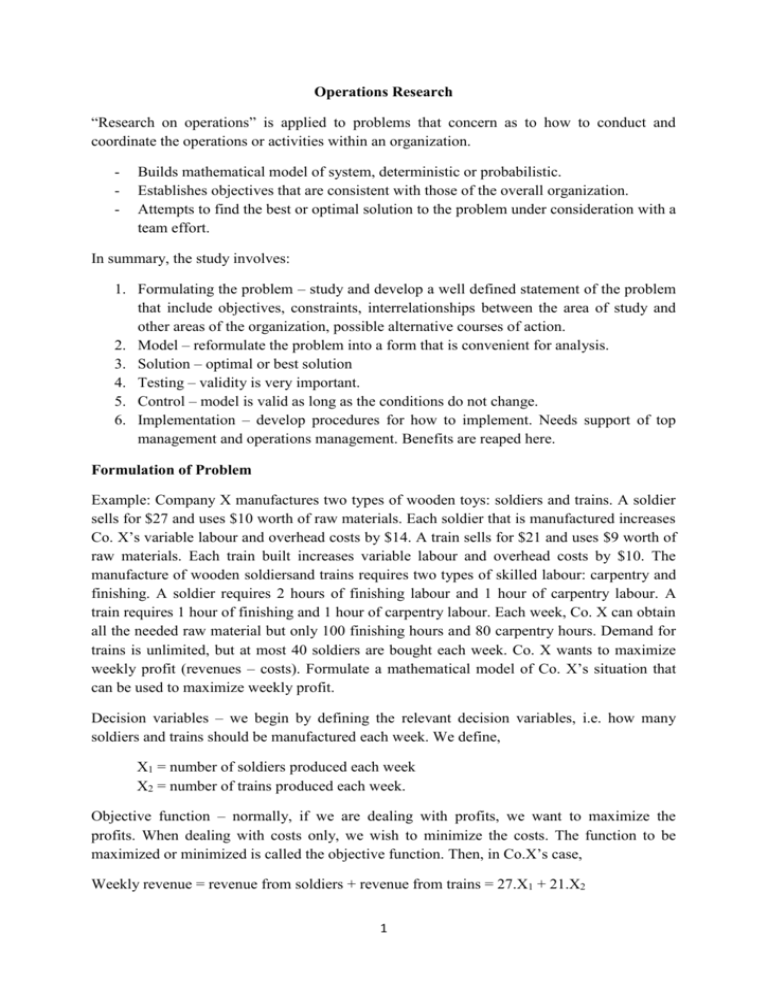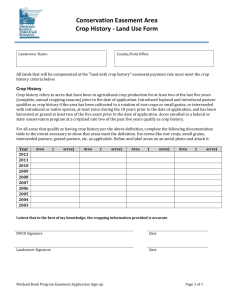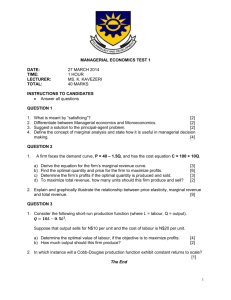Operations Research “Research on operations” is applied to
advertisement

Operations Research “Research on operations” is applied to problems that concern as to how to conduct and coordinate the operations or activities within an organization. - Builds mathematical model of system, deterministic or probabilistic. Establishes objectives that are consistent with those of the overall organization. Attempts to find the best or optimal solution to the problem under consideration with a team effort. In summary, the study involves: 1. Formulating the problem – study and develop a well defined statement of the problem that include objectives, constraints, interrelationships between the area of study and other areas of the organization, possible alternative courses of action. 2. Model – reformulate the problem into a form that is convenient for analysis. 3. Solution – optimal or best solution 4. Testing – validity is very important. 5. Control – model is valid as long as the conditions do not change. 6. Implementation – develop procedures for how to implement. Needs support of top management and operations management. Benefits are reaped here. Formulation of Problem Example: Company X manufactures two types of wooden toys: soldiers and trains. A soldier sells for $27 and uses $10 worth of raw materials. Each soldier that is manufactured increases Co. X’s variable labour and overhead costs by $14. A train sells for $21 and uses $9 worth of raw materials. Each train built increases variable labour and overhead costs by $10. The manufacture of wooden soldiersand trains requires two types of skilled labour: carpentry and finishing. A soldier requires 2 hours of finishing labour and 1 hour of carpentry labour. A train requires 1 hour of finishing and 1 hour of carpentry labour. Each week, Co. X can obtain all the needed raw material but only 100 finishing hours and 80 carpentry hours. Demand for trains is unlimited, but at most 40 soldiers are bought each week. Co. X wants to maximize weekly profit (revenues – costs). Formulate a mathematical model of Co. X’s situation that can be used to maximize weekly profit. Decision variables – we begin by defining the relevant decision variables, i.e. how many soldiers and trains should be manufactured each week. We define, X1 = number of soldiers produced each week X2 = number of trains produced each week. Objective function – normally, if we are dealing with profits, we want to maximize the profits. When dealing with costs only, we wish to minimize the costs. The function to be maximized or minimized is called the objective function. Then, in Co.X’s case, Weekly revenue = revenue from soldiers + revenue from trains = 27.X1 + 21.X2 1 Also, weekly raw materials costs = 10.X1 + 9.X2 Other weekly variable costs = 14.X1 + 10.X2 Profit = (27.X1 + 21.X2) – (10.X1 + 9.X2) – (14.X1 + 10.X2) = 3.X1 + 2.X2 Then, objective function is, Maximize Z = 3.X1 + 2.X2 (The coefficient of a variable in the objective function is called the objective function coefficient of the variable. Constraints – without these, there would be no limit to how much we would produce as the profits inrease with the numbers produced. However, there are limited resources available. Constraint 1 – each week, no more than 100 hours of finishingtime may be used. Constraint 2 – Each week, no more than 80 hours of carpentry time may be used. Constraint 3 – due to limited demand, at most 40 soldiers should be produced each week. Hence, formulating the constraints, 2.X1 + 1.X2 ≤ 100 1.X1 + 1.X2 ≤ 80 X1 ≤ 40 Constraint 1 Constraint 2 Constraint3 (The coefficients of the decision variables in the constraints are called technological coefficients). Sign restriction – if decision variable can only assume non-negative values, we add sign restriction Xi ≥ 0. If both +ve and –ve values can be assumed, Xi is unrestricted in sign (urs). In the example considered, X1 ≥ 0 and X2 ≥ 0. Combining all of the above, Max Z = 3.X1 + 2.X2 2.X1 + 1.X2 ≤ 100 1.X1 + 1.X2 ≤ 80 X1 ≤ 40 X1 ≥ 0 X2 ≥ 0 Constraint 1 Constraint 2 Constraint3 Sign restriction. “ “ 2 Other Formulation Problems 1. Agricultural production is being planned in three regions under the umbrella of a confederation. Agricultural output is limited by both available land and water allocated. Available land and water allocation are given below for the three regions Region Usable land, acres Water allocation, acre feet 1 400 600 2 600 800 3 300 375 The crops to be produced in the confederation (in the three regions), the total acreage for each crop, the water consumption for each crop, and the net return from each crop are given in the following Table. Crop Max. land quota Water consumption Net return Acres acres feet / acre dollars /acre Sugar beets 600 3 400 Cotton 500 2 300 Sorghum 325 1 100 It is agreed that each region will plant the same proportion of its available irrigable land. However, any combination of the crops may be grown at any of the regions. The job of the farmer’s coordinating office is to plan how many acres to devote to each crop at the respective region while satisfying the given restrictions. The objective is to maximize the total net return for the confederation as a whole. Let Xj (j = 1,2,....9) be the decision variables where Xj gives the number of acres to devote to each of the three crops at each region. Region Crop 1 2 3 Sugar beets X1 X2 X3 Cotton X4 X5 X6 Sorghum X7 X8 X9 Objective function: Maximize Z = 400.(X1 + X2 + X3) + 300.(X4 + X5 + X6) + 100.(X7 + X8 + X9) Subject to the following constraints: 1. Land. X1 + X4 + X7 ≤ 400 X2 + X5 + X8 ≤ 600 X3 + X6 + X9 ≤ 300 2. Water 3.X1 + 2.X4 + X7 ≤ 600 3.X2 + 2.X5 + X8 ≤ 800 3.X3 + 2.X6 + X9 ≤ 375 3 3. Crop X1 + X2 + X3 ≤ 600 X4 + X5 + X6 ≤ 500 X7 + X8 + X9 ≤ 325 4. Social (X1 + X4 + X7)/400 = (X2 + X5 + X8)/600 (X2 + X5 + X8)/600 = (X3 + X6 + X9)/300 (X3 + X6 + X9)/300 = (X1 + X4 + X7)/400 Or, these may be written as, 3.(X1 + X4 + X7) – 2.(X2 + X5 + X8) = 0 (X2 + X5 + X8) – 2.(X3 + X6 + X9) = 0 4.(X3 + X6 + X9) – 3.(X1 + X4 + X7) = 0 5. Non-negativity Xj ≥ 0, for j = 1, 2, ......9. Another way of representing the decision variables would be: Xij where i = 1, 2, 3 represent the regions and j = 1, 2, 3 represent the crops. Then, for example, X11 would be eqivalent to X1, X12 to X4, X13 to X7, X23 to X8, X32 to X6, etc. 2. A farmer is raising sheep for market, and wishes to determine the quantities of the available types of feed that should be given to each sheep to meet certain nutritional requirements at a minimum cost. The number of units of each type of basic nutritional ingredient contained within a kilogram of each feed type is given in the following table, along with the daily nutritional requirements and feed costs: Nutritional Ingredient Kilogram of Corn Kilogram of Tankage Kilogram of Alfalfa Minimum Daily Requirement Carbohydrates Protein Vitamins 90 30 10 20 80 20 40 60 60 200 180 150 Costs (cents) 42 36 30 Formulate the linear programming model for this problem. Let X1 : corn s.t. X2: tankage X3: alfalfa Min Z = 42.X1 + 36.X2 + 30.X3 90.X1 + 20.X2 + 40.X3 ≥ 200 30.X1 + 80.X2 + 60.X3 ≥ 180 10.X1 + 20.X2 + 60.X3 ≥ 150 X1, X2, X3 ≥ 0 4





